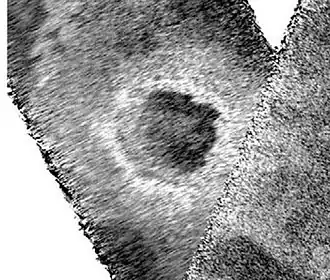Selk (crater)
 A radar image of Selk by the Cassini probe | |
| Feature type | Impact crater |
|---|---|
| Location | Titan |
| Coordinates | 7°00′N 199°00′W / 7.0°N 199.0°W |
| Diameter | 90 km |
| Discoverer | Cassini |
| Eponym | Serket |
Selk is a crater on Titan, a moon of Saturn, located at 7°N 199°W. It is a geologically young impact crater that measures approximately 90 kilometres (56 mi) in diameter.[1] It was discovered in 2004 by the Cassini–Huygens mission during it's first Titan flyby.[2]
There is evidence that ice melted into liquid water when the crater formed, and mixed with organic compounds. This interaction may have formed molecules such as amino acids and other biomolecules.[3] This possibility led mission planners to select the dunes to the Southeast of Selk as the initial landing site of the Dragonfly mission.[4][5]
The crater is named after Serket, a goddess in Egyptian mythology, and was formally approved by the IAU in 2008.[6]
References
- ^ "Geology of the Selk crater region on Titan from Cassini VIMS observations." J.M. Soderblom, R.H. Brown, L.A. Soderblom, J.W. Barnes, R. Jaumann, Stéphane Le Mouélic, Christophe Sotin, K. Stephan, K.H. Baines, B.J. Buratti, R.N. Clark, and P.D. Nicholson. Icarus. Volume 208, Issue 2, August 2010, Pages 905-912. doi:10.1016/j.icarus.2010.03.001
- ^ Lorenz, Ralph D.; MacKenzie, Shannon M.; Neish, Catherine D.; Gall, Alice Le; Turtle, Elizabeth P.; Barnes, Jason W.; Trainer, Melissa G.; Werynski, Alyssa; Hedgepeth, Joshua; Karkoschka, Erich (2021-02-01). "Selection and Characteristics of the Dragonfly Landing Site near Selk Crater, Titan". The Planetary Science Journal. 2 (1): 24. Bibcode:2021PSJ.....2...24L. doi:10.3847/PSJ/abd08f. ISSN 2632-3338.
- ^ Wakita 脇田, Shigeru 茂; Johnson, Brandon C.; Soderblom, Jason M.; Shah, Jahnavi; Neish, Catherine D.; Steckloff, Jordan K. (2023-03-01). "Modeling the Formation of Selk Impact Crater on Titan: Implications for Dragonfly". The Planetary Science Journal. 4 (3): 51. arXiv:2302.11330. Bibcode:2023PSJ.....4...51W. doi:10.3847/PSJ/acbe40. ISSN 2632-3338.
- ^ Hautaluoma, Grey; Johnson, Alana (27 June 2019). "NASA's Dragonfly Will Fly Around Titan Looking for Origins, Signs of Life" (Press release). NASA. Retrieved 2019-08-16.
- ^ Lorenz, Ralph D.; MacKenzie, Shannon M.; Neish, Catherine D.; Gall, Alice Le; Turtle, Elizabeth P.; Barnes, Jason W.; Trainer, Melissa G.; Werynski, Alyssa; Hedgepeth, Joshua; Karkoschka, Erich (2021). "Selection and Characteristics of the Dragonfly Landing Site near Selk Crater, Titan". The Planetary Science Journal. 2 (1): 24. Bibcode:2021PSJ.....2...24L. doi:10.3847/PSJ/abd08f. hdl:10150/662019. S2CID 233934724.
- ^ "Selk". Gazetteer of Planetary Nomenclature. International Astronomical Union (IAU) Working Group for Planetary System Nomenclature (WGPSN). Retrieved 15 August 2019.
